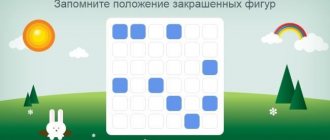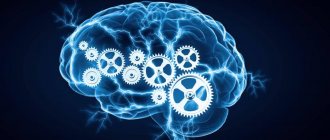Younger schoolchildren at their age experience an active increase in the arbitrariness of mental processes, which is very important. The ability to choose a guideline and make efforts to achieve goals while receiving new information provides an excellent opportunity for a child to successfully study at school. It is for this reason that good voluntary memory is so important for children.
Many adults are confident that their children have excellent memory, since they are able to remember this or that information without any problems. However, imagine their surprise when the child, having become a schoolchild, loses this ability. In fact, there is nothing surprising in this, it’s just that the parent must take time to worry about developing voluntary memory in the child, which is the leading mental process in primary school.
In this article we will talk in detail about what exercises exist to develop memory in primary schoolchildren, and how to do them correctly.
What types of memory are there?
To choose appropriate exercises for memory development, it is worth understanding how the memorization process occurs. To do this, let us turn to the generally accepted classification of memory.
- By duration:
- short-term (information is remembered easily, but also easily forgotten);
- long-term (data is stored in memory for a long time);
- prompt (information is retained for some time).
- Type:
- auditory (what is heard is better remembered);
- visual (visual images are easier to remember);
- motor (everything related to movement - remembers the body);
- figurative (emotional, associative);
- By degree of effort:
- involuntary (no effort required to remember anything);
- arbitrary (you need to try to remember an event or object);
- immediate (memorized mechanically, thinking does not “turn on”);
- indirect (requires building a logical chain, understanding the data).
By the way, children have a well-developed mechanical memory, so experts recommend starting to study foreign languages before school.
How does human memory work? There are three stages here:
- memorization;
- data storage;
- retrieval (reproduction) of data.
How to develop long-term memory?
Human memory is quite subjective, since after each subsequent reproduction of information, memories are distorted.
The task of parents is to develop and train the child’s long-term memory. To do this you need:
- Teach your child the ability to compare objects of memorization, find similarities and differences in them (children's magazines with colorful pictures and tables are suitable for training, in which you are asked to find either identical objects or find subtle differences in them);
- Practice retelling by the child any information he has received - a cartoon he has watched, a story he has read, an experience he has experienced (trains memory, develops speech, allows him to correctly compose sentences);
- Learn poems, tongue twisters, solve crosswords;
- Gradually move on to memorizing prose (one interesting exercise can be suggested here). For example, read a small passage of text in a magazine and cut out this fragment. Then cut it into pieces, give the child one part and offer to reconstruct the entire plot from it.
Photo report
Prepare a picture in advance, for example this one.
Action plan:
- Show your child a picture and invite him to “take a photo” of it with his inner “camera.”
- After 30 seconds, remove the picture.
- Ask your child to answer the questions.
Questions for our sample could be the following:
- How many shelves are hanging on the wall?
- What is written on the bed linen?
- Who's lying on the bed?
- What color is the wardrobe and bedside tables?
- What's on the windowsill?
- What time is on the clock?
- Where does the turtle sit?
- How many lamps are there in the room?
- What color are the curtains?
- Is there a violin in the room?
There are a lot of similar exercises in children's magazines.
Training auditory memory
The more we train our memory, the more we can remember. So, let’s begin exercises to develop auditory memory in younger schoolchildren. Classes can be conducted both in groups and individually.
- Add yours
This exercise is good to practice in a group. This is the principle here. An adult suggests a simple plot, for example, a trip or a trip to the store. It starts like this: “I put a book in my suitcase (bag). The child must repeat this sentence from the beginning and add something of his own. For example: “I put a book and pencils in my suitcase (bag). The second participant in the class repeats everything from the beginning again (the phrase is already longer) and adds his own.
- Remember the rhythm
With a pencil or stick, you tap on the table in a certain rhythm and invite the child to repeat it. You need to start with simple sounds; as the student masters it, the rhythm can be complicated.
- Let's sing songs
For the development of auditory memory, such a simple technique as singing songs in the voices of familiar cartoon characters, for example, effectively helps. In order to imitate someone else's voice, the child will have to remember its timbre, volume, intonation and rhythm.
- Looking for a couple
The training consists of two stages. In the first stage, you read pairs of words. For example: flower - vase, school - student, hare - forest, river - bank. At the second stage, you name one word from the read pair and invite the child to name the second. If your student copes, then everything is fine with both memory and logic.
- Let's play in associations
This is a more challenging exercise, although your child will definitely enjoy it. Prepare several cards on which you depict objects and animals. For example, fox, sweater, sun, bus. Place the cards in front of your child. Set a task: you name the words, and the child selects a picture to go with them. Words could be: forest, clothes, weather, garage.
Teaching memorization techniques in exercises
Younger schoolchildren are able to use special memorization methods themselves, which are called “mnemonics.”
If a child learns to use mnemonic methods, he will develop voluntary memorization, which will make it possible to simply and quickly absorb the necessary material.
Many parents are interested in what techniques should be used to teach children to memorize. Thus, there are special exercises for the development of visual memory in younger schoolchildren, which are mainly carried out in a fun and playful way. Below we present to your attention several tasks that will help you easily and simply develop your child’s memory.
Visualization exercises
Exercise 1 “Remember and Draw”
The task promotes the development of visualization.
The parent should slowly dictate different words to the child, while offering to draw on paper the image that arises when imagining them. After this, focusing on his own drawings, he must reproduce the dictated words. To maintain your baby's interest, you should change the words.
Exercise 2 “Drawing with matches”
This exercise is a more difficult variation of the above. So, instead of drawings, the student must create an image from matches. The elder must pronounce the words at intervals of 1 minute, and the child reproduces the image during this time. This activity develops not only visualization, but also fine motor skills.
Exercise 3 “Imagine what you remember”
The proposed exercise allows the child to develop conscious reproduction of objects and forms concentration.
Baby, for 30 seconds. offer to look at images of one or another object familiar to him, after which they close. The student must depict on paper those objects that he was able to remember. As a result, the drawings are compared. Over time, the number of images shown should gradually increase. It may be quite difficult for the child at first to reflect on paper everything that was shown to him, but over time, he will improve his skill.
Exercise 4 “Imagine an object”
This exercise is aimed at developing auditory and visual memory in younger schoolchildren; in addition, thanks to it, the child’s vocabulary is also activated.
The parent tells the child words and asks him to imagine the objects that they represent. After this, the child must talk about the item that he remembers. To develop visual memory, it is necessary to use drawings of such objects.
Exercise 5 “Memorize and find”
This exercise will allow you to “turn on” conscious reproduction. The child is asked to remember a certain number of pictures that depict certain objects. After this, the pictures are removed, and the student must find objects in other pictures.
Association exercises
The method of exercises for developing memory in children in the form of association tasks has long been considered a classic technique widely used by psychologists.
Such exercises allow you to develop voluntary memory skills. This skill will come in handy for a student when memorizing information in an educational institution, especially in situations where some concepts are not logically connected, for example, during mathematics, in particular the multiplication tables.
Exercise 1 “Which picture will help you?”
The parent invites the child to look at the pictures (up to 20 pieces). Gradually voicing the words that need to be remembered, the adult invites the child to choose a picture that would allow the latter to remember this word. After all the words are listed, the baby, from memory, as well as with the help of the pictures he has, must reproduce all the words that he heard and remembered. This task does not require haste; it is necessary to give the child the opportunity to form an associative chain between words and pictures. Initially, parents can help the student choose the appropriate image. Despite the fact that at first glance this exercise is not easy, it trains children’s memory in the best possible way.
Exercise 2 “Make up a story”
This exercise is quite difficult, it is aimed at developing voluntary memory and is suitable for second or third grade students.
The parent voices to the child a certain number of words that need to be combined into a single group, based on one of their common features. After this, the child must create a situation where all the words heard could be collected into one plot.
It is best to start working on this exercise with those words that have a logical connection with each other, gradually complicating the task. Such activities will help not only develop memory, but also improve associative thinking and imagination. So, over time, the student will be able to combine even those words that are both externally and logically unrelated.
Parents should not limit the student's imagination in any way while he is composing his story. Let the child independently find associations, even if at first they are not entirely clear.
Memory exercises
If we take into account primary school students, we can identify groups of children who remember this or that educational material in their own way. Thus, some children can immediately recreate what they heard, others easily remember information without any problems, but forget it very quickly, and still others, on the contrary, memorize for quite a long time and quickly forget the educational material.
It is for this reason that some parents have to make a lot of efforts to ensure that their children are prepared for the fact that they will have to memorize complex material. In this regard, we invite you to familiarize yourself with some techniques that are precisely aimed at ensuring that the student can learn to comprehend what he remembers.
Exercise 1 “Introducing a poem”
This exercise allows you to teach your child to think in images. Basically, this method comes in very handy when memorizing poems. The parent teaches the student, while reading the text, to mentally imagine a picture - this is the basis of memorization. To make it more clear, we suggest that you familiarize yourself with the algorithm for carrying out this exercise:
- The first line of the poem is read.
- What is read is presented.
- Similar work is done with selected quatrains.
- Fictional images are remembered, and the student tries to connect them with the lines of the poem.
- The poem is read again, based on the images.
Exercise 2 “Collecting the text”
For older children or for those who are already quite advanced in their studies, you can try tasks that relate to memorizing texts. Thus, psychologists and teachers in this area have already developed a special and at the same time quite original methodology. In particular, if in general terms, the divided text into parts needs to be glued together.
To do this, the adult prepares the text on a separate sheet of paper, which the student must read, after which the content is discussed. Next, the read text is divided into parts. By the way, you can also involve a child in the cutting process. After this, the student must collect all parts of the text in its original form.
As a rule, such an activity is very exciting for children, since it includes not only the thought process, but also the opportunity to do something independently with their own hands. However, an adult must properly prepare for the lesson by printing out the text so that the child does not start cutting the book or textbook.
Exercise 3 “Couples”
The student is dictated paired words, which must then be reproduced after listening in the same order, and only based on the first word. Having mastered such an exercise, the student will subsequently be able to independently come up with “pairs” for words. Such training is best practiced in a family circle, when all household members take part.
Exercise 4 “Chain of words”
The parent dictates 10 words to the child, which the latter must remember. After this, the baby reproduces them in the same order. It is best to try to reward the student for each correct answer.
Exercise 5 “Crosswords, puzzles”
A lot of such exercises can be found in a variety of printed publications. They will not only force the baby to think logically, but will also help develop the child’s ability to remember certain terms.
Visual memory
To develop this type of memory, you can use the following exercises:
- Color pictures
You will need from three to five pictures of different colors. Show them to your child in a certain sequence and ask them to repeat. Check for correctness.
- Geometric figures
This exercise trains photographic memory well. Draw a cartoon character in the form of geometric shapes on a piece of paper. As usual, this is either a robot or an astronaut/alien. There should be no more than four geometric shapes. Show your child the drawing for 30 seconds so that he can study it in detail. Then ask them to draw what they remember. You can prepare three drawings in advance. At each subsequent one, slightly change some detail. When checking a task, pay attention to how accurately it was completed.
- Describe the picture
You need to prepare up to five versions of drawings that depict several objects. The shape and color are different. Let your child study what is shown for 10 seconds, then let him close his eyes and describe in detail what he remembers. Gradually, the task can be complicated by increasing the number of objects in the picture.
"Rainbow Confusion"
There are exactly 7 colors in our earthly rainbow. And they are located in a certain order (here you can remember the correct order and talk about “every hunter wants to know...”) But on the planet “Confusion” the rainbow looks different. All the colors in it are mixed up. And every day they change places. The inhabitants of this cheerful planet have to remember a new order of colors in the rainbow every time.
You will need cards of all the colors of the rainbow: red, orange, yellow, green, blue, indigo and violet. Place them in random order on the table and cover with a sheet of paper.
Action plan:
- Show your child the cards and ask them to look carefully and remember in what order they are.
- After 15 seconds, cover them with a sheet of paper.
- Ask your child to remember in what order the cards were laid out on the table.
If this exercise causes difficulty, you can start with four colored cards, and then increase their number.
Developing associative memory
The development of associative memory in elementary school students is a very effective method. There is a whole science for training the formation of associations - mnemonics. Exercises to develop associations include diagrams, tables, pairs of words that are not related in meaning. Regarding the latter, name a couple of words that have different meanings and give the child the task of coming up with a story using these words. And diagrams and tables with pictures will teach children to write stories; perform some manipulations in a certain sequence, for example, getting dressed. Mnemonic diagrams help increase vocabulary and quickly memorize text. They say that a poem is best remembered if you “see” it.
How to improve a student's memory?
If you see that your student is inattentive, does not remember well what he is told at school and at home, and cannot concentrate, of course, you should not put up with this state of affairs. It takes effort, and your child will study better, become more focused and generally more successful. And there are several simple ways to do this.
- Read good literature
Of course, it is difficult to tear a modern child away from correspondence on social networks, watching cartoons, and computer games. But for loving parents nothing is impossible. Convince your child, using personal example, that reading is not only useful, but also fashionable. Give him an e-reader so he can read whenever he gets the chance. Choose good literature for him.
- Learn new things
Mastering new skills trains your memory very well. If your child does not play sports or attend hobby groups, tell him that all this exists and is available. If he is already doing something, offer to learn a new sport or attend a music school, and at the same time find out what your child is passionate about.
- Develop your vocabulary
Not only reading books will help here. You can organize this game at home: every day - a new word. Introduce your child to difficult words; the Internet will help them interpret them. It will be interesting and useful for parents too.
- Learn from memory
Learn poems assigned at school with your child. Tell him about your poetic preferences, how you memorized poems as a child.
- Remember the numbers
Memorizing numbers has a great effect on memory development. These could be dates of birth of relatives and friends, mobile phone numbers. Tell your child how best to remember them. If there are other children in your family, organize a competition between them “Who can remember the most.”
- Get proper rest
Healthy sleep, sufficient time for a child of primary school age (at least 10 hours in a well-ventilated area), as well as walks in the fresh air (up to two hours daily) perfectly stimulate brain function and, accordingly, have a positive effect on memory. Don't neglect these simple rules.
Exercises to develop motor memory
- "Repeat after me". Show one or more movements. Offer to repeat. It is important not to voice the movements; the child will remember them by duplicating them.
- "Dance with Me". Play some fun music and encourage your baby to dance. Show him the movements and let him repeat after you. For example, learn a funny dance.
- For fine motor skills, use coloring books or copybooks. Copywriting will help preschoolers develop good, neat handwriting. And activities with coloring books are exciting and also develop imagination.
- Modeling. Buy plasticine or playdoh, or prepare salt dough. Make all sorts of figures with your child, then complicate the tasks. In such a fun and unobtrusive way you will develop your baby’s fine motor skills.
Training does not end with special exercises and games. Try to consolidate the baby’s memory at every moment of joint leisure. Ask to complete several tasks or bring several toys at once. Ask what he did in kindergarten or what he saw. Ask to retell a cartoon or fairy tale.
Of course, the proposed exercises require a lot of time and patience from parents. You will have to give up your interests. But the efforts will bring long-awaited results. Your baby will be able to boast of good knowledge. Remember, regular work is the key to success!
Educational games to improve memory - on the IQClub website
To develop memory, not only exercises are used, but also games. IQClub is an Internet service that offers educational games for training a child’s memory, attention, reading skills, and thinking. To use the services of this online portal, you need:
- register in the system;
- for a child to take a test that interests him.
After this, IQClub specialists will select an individual training program for your child, based on an analysis of his strengths and weaknesses.
Game development is carried out by a team of professionals - the best psychologists, teachers, designers.
Parents can track learning results online. Useful games on the IQClub website are an excellent simulator for developing a child’s intelligence.
Recommendations for developing the memory of younger schoolchildren
Memory is given to each of us at birth, but not everyone can use it correctly. The task of parents and teachers is to teach the student memorization techniques so that he subsequently uses them unconsciously. The child must understand for himself how it is easier for him to remember information. However, any science will not be useful if the student lacks motivation to study. In such a situation, it is the sacred duty of the parents to interest the child, and for a good result, conduct classes systematically. During these classes, educational psychologists recommend that parents pay attention to the following:
- make sure that the child understands the material he is memorizing;
- let the child repeat the learned text the next day;
- when working on memorizing a text, break it into small passages, but not very small, so that your student does not forget what happened at the very beginning;
- while memorizing a text, ask your child to pronounce it out loud;
- motivate your child to memorize, show imagination: offer for study only those texts that are really interesting to him;
- Work with your child for no more than half an hour, and at first for 15 minutes. If you see that the baby is tired, take a break;
- always praise your child for even the smallest successes, encourage him to practice.
When working with your child, help him complete tasks, tell him what memorization tactics are best to use. Thus, your baby will not only learn to remember, he will perceive information consciously and then it will remain in his memory for a long time.
Working with mentally retarded children
The most problems arise when working with children who are developmentally delayed. The lag may occur due to illness or lack of work with a child - most often from disadvantaged families.
Of course, there are also special exercises for developing the memory of mentally retarded schoolchildren. But you can also use those described above. You just need to set the bar much lower and raise it much more slowly. For example, when developing visual memory, show not three cards, but two, and do more repetitions. To develop logical memory, use very short texts - just a few sentences.
Thanks to this approach, the child quickly catches up, and the gap between him and other children (if the reason is neglect, and not physical disability) is reduced much faster.











